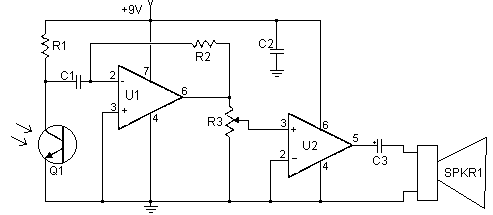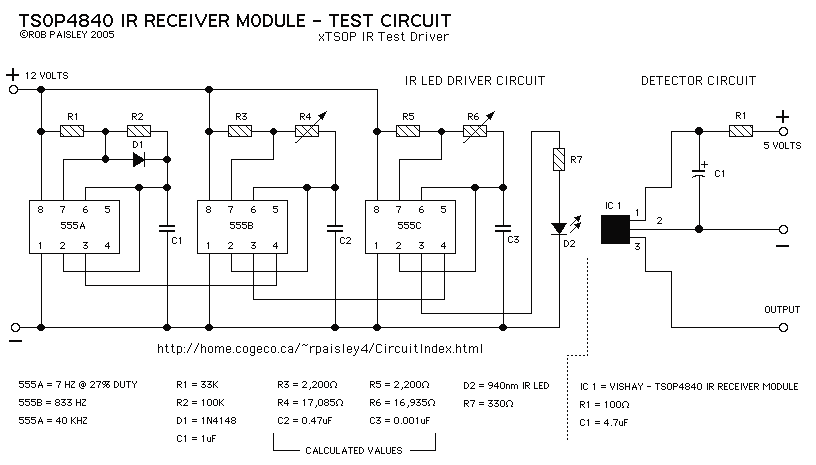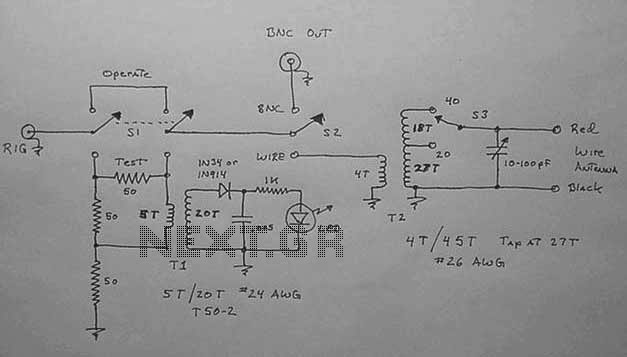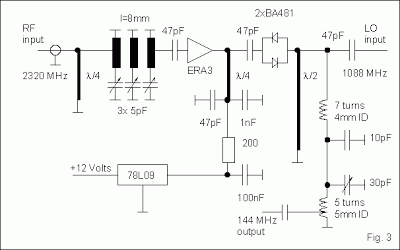
Serial port Infrared Receiver
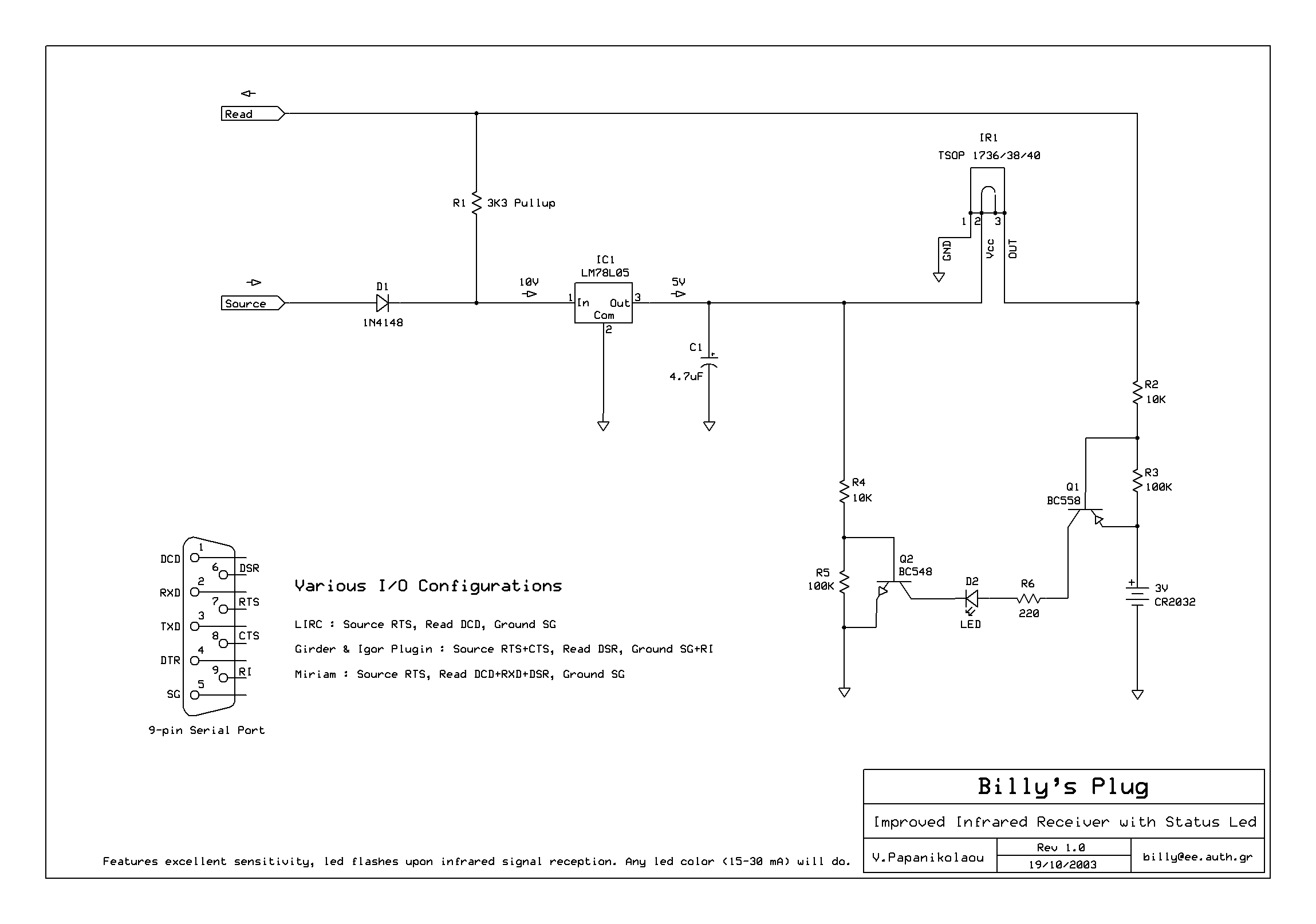
This is a general purpose serial port infrared receiver. With the help of appropriate software, you can control different functions of your PC from a distance. For example, you can control your home cinema settings (volume, play, pause, stop, etc.), your Winamp, etc.
It uses for receiver TSOP 1738 (38 KHz) but it worked well with TSOP 1736 (36 KHz) and a remote Sony which works at 40MHz.
The two transistors light up the LED when a signal is received. Any kind of LED will fit. More: The software that can be used are:
- Girder + Igor Plugin
- WinLIRC
- Miriam
- IRAssistant
But keep in mind that each software uses different pin out. Details can be found at the schematic.
The circuit described is a versatile infrared (IR) receiver designed to interface with a personal computer via a serial port. The core component of the system is the infrared receiver module, typically a TSOP 1738, which is sensitive to modulated IR signals at a frequency of 38 kHz. This module can also operate with TSOP 1736 (36 kHz) and is compatible with certain Sony remotes that transmit at 40 MHz, demonstrating its flexibility in receiving signals from various sources.
The schematic features two transistors configured in a manner that allows them to drive an LED indicator. This LED serves as a visual feedback mechanism, illuminating when the receiver detects an IR signal. The choice of the LED is non-specific, meaning that any standard LED can be utilized, providing adaptability in terms of component selection.
The circuit is designed to interface with multiple software solutions, including Girder with the Igor Plugin, WinLIRC, Miriam, and IRAssistant. Each of these applications may require specific pin configurations to function correctly, which should be referenced in the accompanying schematic. This emphasizes the importance of consulting the schematic for accurate wiring and connectivity, ensuring that the receiver operates as intended across various software platforms.
In summary, this general-purpose infrared receiver circuit is a practical solution for remote control applications, allowing users to manage their PC and connected devices wirelessly. Its compatibility with different IR receiver modules and software enhances its usability in diverse scenarios.This is a general purpose serial port infrared receiver. With the help of appropriate software (see below) you can control different functions of your pc from a distance. For example you can control your home cinema settings (volume, play, pause, stop etc), your winamp etc.
It uses for receiver TSOP 1738 (38 KHz) but it worked well with TSOP 1736 (36 KHz) and a remote Sony which works at 40Mhz. The two transistors light up the led when a signal is received. Any kind of led will fit. The software that can be used are: # Girder + Igor Plugin # WinLIRC # Miriam # IRAssistant But keep in mind that each software uses different pin out. Details can be found at the schematic. 🔗 External reference
It uses for receiver TSOP 1738 (38 KHz) but it worked well with TSOP 1736 (36 KHz) and a remote Sony which works at 40MHz.
The two transistors light up the LED when a signal is received. Any kind of LED will fit. More: The software that can be used are:
- Girder + Igor Plugin
- WinLIRC
- Miriam
- IRAssistant
But keep in mind that each software uses different pin out. Details can be found at the schematic.
The circuit described is a versatile infrared (IR) receiver designed to interface with a personal computer via a serial port. The core component of the system is the infrared receiver module, typically a TSOP 1738, which is sensitive to modulated IR signals at a frequency of 38 kHz. This module can also operate with TSOP 1736 (36 kHz) and is compatible with certain Sony remotes that transmit at 40 MHz, demonstrating its flexibility in receiving signals from various sources.
The schematic features two transistors configured in a manner that allows them to drive an LED indicator. This LED serves as a visual feedback mechanism, illuminating when the receiver detects an IR signal. The choice of the LED is non-specific, meaning that any standard LED can be utilized, providing adaptability in terms of component selection.
The circuit is designed to interface with multiple software solutions, including Girder with the Igor Plugin, WinLIRC, Miriam, and IRAssistant. Each of these applications may require specific pin configurations to function correctly, which should be referenced in the accompanying schematic. This emphasizes the importance of consulting the schematic for accurate wiring and connectivity, ensuring that the receiver operates as intended across various software platforms.
In summary, this general-purpose infrared receiver circuit is a practical solution for remote control applications, allowing users to manage their PC and connected devices wirelessly. Its compatibility with different IR receiver modules and software enhances its usability in diverse scenarios.This is a general purpose serial port infrared receiver. With the help of appropriate software (see below) you can control different functions of your pc from a distance. For example you can control your home cinema settings (volume, play, pause, stop etc), your winamp etc.
It uses for receiver TSOP 1738 (38 KHz) but it worked well with TSOP 1736 (36 KHz) and a remote Sony which works at 40Mhz. The two transistors light up the led when a signal is received. Any kind of led will fit. The software that can be used are: # Girder + Igor Plugin # WinLIRC # Miriam # IRAssistant But keep in mind that each software uses different pin out. Details can be found at the schematic. 🔗 External reference
